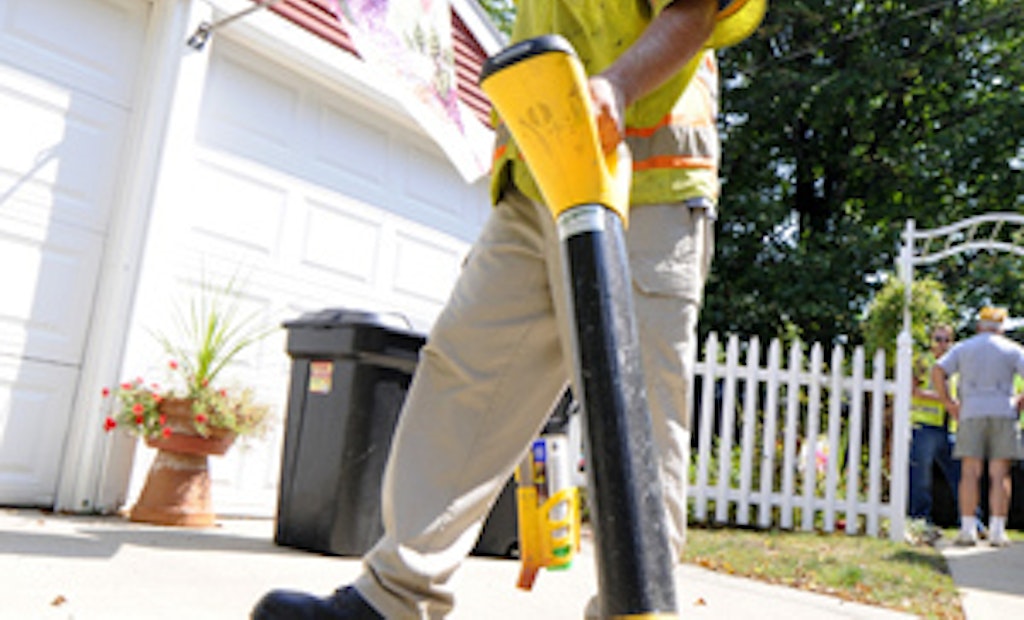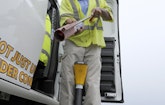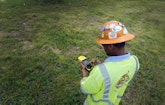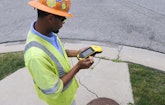
Interested in Inspection?
Get Inspection articles, news and videos right in your inbox! Sign up now.
Inspection + Get AlertsBlood Hound Underground lives up to its name as a company that provides just one service – underground locating. President Mark Mason’s credo: “If you do one thing, you’d better do it extremely well.”
The company has maintained its reputation through rapid expansion by investing in technology, employing rigorous training and quality control programs, and focusing on the safety of its employees.
Mason started in the business at the age of 19 as a technician with a company that offered contract locating services. He eventually wound up as a district manager in a locating firm, where he noticed the private locating market was underserved.
“When the parent company closed in 1999, I was the first person in management to be let go,” Mason said. “I was a technician first and a management type second. I used my lump sum severance payment to buy an electromagnetic (EM) locating system. Private utility locating is a low-margin service for those companies who don’t specialize in it. By specializing, I believed I could make a profit.”
Mason founded Blood Hound that same year in Brownsburg, Ind., just west of Indianapolis. He says he invested particular effort in selecting the company name.
“It not only has to be catchy, it has to tell the customer exactly what you offer,” he says. “You want a name big enough to grow with the company.”
Most municipalities have “one-call” phone numbers designed to provide the location of utilities. “But their assistance ends on private property,” he says. “You usually won’t get enough information that you would risk a lawsuit or accident going forward.”
Mason says he initially drove around to drum up business, offering EM services. “If I saw a guy with a backhoe, I would hand out a business card,” he says. “The work just began to compound from there.”
EM locating provides business base
EM locating involves using a transmitter to induce a signal into the actual utility conduit – pipe or wire – then following that signal along the ground using a receiver.
Blood Hound contracts range from locating the water, wastewater and fire protection system lines in a large manufacturing concern or university campus, to finding electric conduits in a shopping center parking lot. Clients include municipalities, engineering firms, property managers, excavating companies and environmental remediation firms.
About half the company’s contracts involve private sewer and waterline locating. Often the work is subcontracted by private companies, engineers, or construction companies assisting public utilities.
Sometimes clients get more than they’re asking for.
“We often get a client asking us to locate a sewer or a waterline,” says Mason. “Once we start, we might ask them whether they’d like us to map the fiber optic cable running alongside it. That usually gets their attention.”
Expanding out of state
Mason expanded out of state with a call from Delta Environmental Consultants Inc., (now Antea Group) in Novi, Mich., in 2002. “They were doing environmental work for BP and needed private locating done,” says Mason.
Initially Mason worked the contract, but then sent his first employee, his father Robert, a retired firefighter. A year later, Mason hired his brother and eight family members.
The company has since expanded to include five locations, including Cincinnati, Knoxville, Fort Wayne, and Indianapolis, and service is offered nationwide. Blood Hound has worked contracts as far away as California, Nebraska, Texas, New York City and Canada. All work is done using ground vehicles from one of the five offices.
“We carry so much equipment, we need to drive everywhere,” says Mason.
Vivax-Metrotech Corporation supplies most of the company’s EM locators, an inventory of about 100 units. Blood Hound also assisted South Carolina-based Jameson LLC to develop a fiberglass rodder with a built-in metal tone wire to assist with EM locates on plastic gas and sewer lines that would otherwise be invisible. The tone wire rodder has a range of either 500 or 750 feet, depending on which model is used.
Early on, Mason experimented with the range of equipment and ancillary services he offered.
“For the first few years we offered excavation and sewer and waterline repair,” he says. “I eventually asked myself why I was in the excavating business, competing with people who were beating up on each other on low profit margins. Our resources were better spent closer to our core business.”
Five-point service menu
Eventually, Blood Hound settled on a list of services that include:
EM
Ground penetrating radar
Vacuum excavation
Global Positioning System (GPS)/Geographical Information System (GIS) mapping
Closed-circuit television (CCTV) inspections
Ground penetrating radar (GPR) is used to find utilities that are untraceable or have no direct access. Among the targets of the technology are underground storage tanks, plastic sewer and waterlines, septic tanks and anything missed using EM.
GPR allows for real-time visualization of subsurface features. Blood Hound’s inventory includes 30 to 40 GPR units.
“We use MALA GeoScience units for day-to-day work, US Radar for intermediate work and Sensors & Software for more advanced and finicky work,” says Mason.
More recent models feature larger wheels and an independent suspension to allow for more effective surveys over rough terrain.
“Knowing the limits of EM and GPR to determine an exact depth, we will hydroexcavate, usually to between five to eight feet down, especially around highly sensitive utilities like high-pressure gas lines,” says Mason. The company also offers air-knife excavation and employs three Ditch Witch vacuum excavators.
After capturing location data, Blood Hound can create a permanent GPS or GIS record of utility locates. The data can later be used to produce maps or be incorporated into the client’s computer location database. Typically, technicians employ Trimble GeoExplorer series data recording units with exterior antennas from Trimble Navigation Limited.
Blood Hound uses fiber optic reel-mounted CCTV cameras as well as robotic-mounted cameras to televise underground utilities from 1-inch conduits to 60-inch storm sewer lines to a range of up to 500 feet. The company features cameras by RIDGID and Vivax-Metrotech in tandem with a radio-frequency locator that pinpoints structural faults and other problems.
“We used the cameras extensively when we worked on preconstruction for Lucas Oil Stadium in Indianapolis,” notes Mason. “We pushed the cameras through every kind of duct and conduit leading from the construction site to see which were usable and unusable.”
Recognizing that various clients require different ranges of services, Blood Hound offers tiered pricing packages. Tier 1 pricing applies to residential customers requesting EM locating only, while Tier 2 pricing is based on the individual services ordered.
Tier 3 offers pricing based on a flat rate, including EM, GPR and CCTV service. “At this level, we offer limited liability to the customer,” says Mason. “If we overlooked something we will take care of it. However, if we aren’t given full access to the utility chase and damage occurs later, what happened will be open to interpretation. In Tier 4 we offer the same services and accept liability to $10,000 for repair of damaged utilities, subject to the terms of contract.”
Most training developed in-house
The company prides itself on thorough training, with all technicians certified at Staking University in Manteno, Ill., a training facility for subsurface utility locating practices. However, most of the company’s training is so specific that Blood Hound generates about 90 percent of its own training materials.
“Part of our training involves taking technicians to different customers so they can understand the infrastructure and how it changes from a water purification facility to a force main sewer to a nuclear power plant,” says Mason. “At an airport, for example, they have a lot of icing problems. When the water is captured after de-icing they have a special storm system of valves and conduits that our technicians need to understand when performing a locate.”
Safety training includes OSHA 30-hour construction safety, 40-hour Hazardous Waste Operations and Emergency Response (HAZWOPER), work zone traffic, confined-space training, defensive driving, electrical safety, and emergency action planning. The training has helped to develop business relationships with companies where contractor safety is critical.
Auditing of the company’s own work is handled in-house by a quality assurance manager. One team member is assigned to about 10 technicians to check a percentage of locates and ensure all paperwork has been filed correctly.
“We recently completed a job in Manhattan locating lines buried in a concrete pier, and the client was shocked that we had gone through the expense of sending someone out to double-check the work,” says Mason. “If there’s a problem, we make it right. We track the reports and look for trends, either in equipment, software or individual technicians, to see how we can improve the final product.”
Mason pays particular attention to his company website, where he can make a good first impression on clients. “You want a professionally prepared site to let the customer know that you’re a professional company,” he says.
The bloodhound motif is featured prominently – you can even hear it bark – but that’s just window dressing. The site acts as both a sophisticated online work scheduling tool and educational resource. Clients can select service appointment dates online. A series of videos explain the technology the company uses and how that technology can work for customers.
“We’ve put a lot of work into the videos,” notes Mason. “We want to show the customer that we’re embracing advanced technology and we update the videos regularly so there’s always something new on the site. Our technicians will often pull out an iPhone, Droid or iPad in the field so they can provide customers with all the information available to make an informed decision about which solution to choose.”
Third-party expertise
The company launched a subsidiary, Utility Damage Investigations Inc., in 2003. It employs four in-house experts who specialize in third-party utility damage investigations and expert witness services.
“You’re a contractor installing a water main and you damage a fiber optic telephone cable conduit that was mismarked,” says Mason. “You receive a bill for $50,000 in damages and suddenly we’re in a legal debate about who is responsible. The contractor will need to mount a defense, but quite often even the photos used as evidence will be shot at angles that benefit the party who took them. As the investigator, we’ll investigate impartially, discover the root cause of the damage, and tell the client whether we believe they’re at fault. If they are, we’ll try to mitigate their costs.”
UDI also audits out-of-house locating services, usually for municipal utility companies.
Custom scheduling software
The company uses Enterprise Resource Planning software developed in-house from the ground up to allocate human and material resources across all regions. Technicians can be cross-referenced according to their capabilities and safety training. The software is part of the company’s two-year plan to go completely paperless.
Blood Hound continues to grow – it had record sales in 2009 and 2010, difficult years for competitors. A dedicated sales force, including a manager of business development, helps to keep the company busy.
“We are planning for continued growth, as long as we can maintain our level of service quality,” says Mason. “It takes a year or two of training to get our technicians to fully wrap their heads around what they’re doing. Of the 10 we hire, we might keep three or four. We don’t want to grow unless we know we’re sending out the best of the best.”













